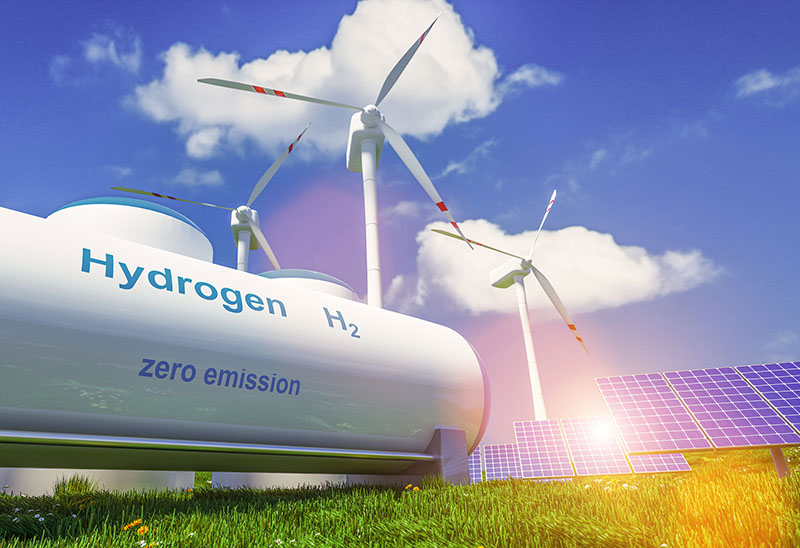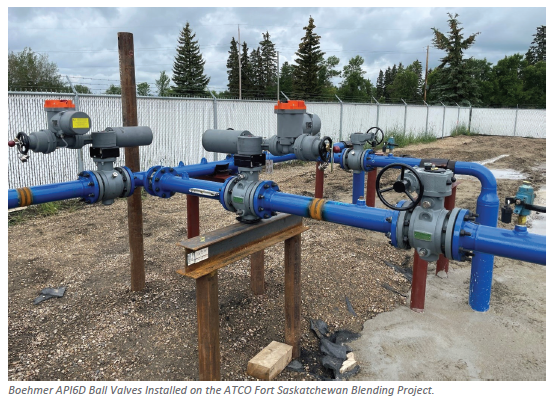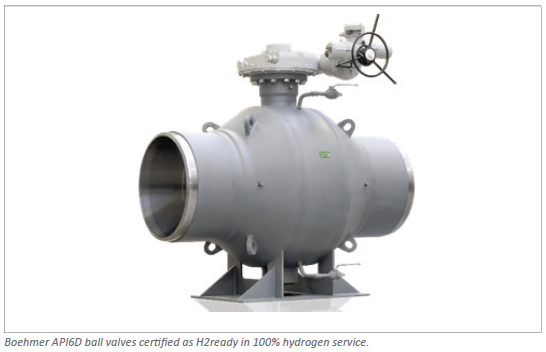Blending hydrogen with natural gas to create a cleaner fuel source is a globally accepted approach to reducing greenhouse gas (GHG) emissions. This article explores the benefits of hydrogen blending in natural gas pipelines and best practices for selecting ball valves for hydrogen blending applications.
By Marc Soucy – National Sales Manager, Armour Valve
When hydrogen is burned, it releases water vapor, unlike natural gas that releases carbon dioxide (CO2), making it a cleaner alternative to other fuel sources. This blending process supports a smooth transition towards decarbonizing energy systems without costly replacements or upgrades of existing infrastructure.
Typically, hydrogen is blended at concentrations of up to 20% by volume within existing natural gas pipelines. This practical solution addresses the challenges posed by the often limited and inconsistent supply of hydrogen, ensuring a steady and adaptable shift towards cleaner energy. The flexibility of this approach is essential, allowing for the gradual integration of hydrogen into current infrastructure, with necessary adjustments to meet technical, economic, and safety requirements.

Benefits of Hydrogen Blending
Hydrogen blending offers a range of benefits that contribute to its growing popularity as a strategy for reducing greenhouse gas emissions and transitioning to cleaner energy sources.
Lower Greenhouse Gas Emissions
One of the most significant advantages of hydrogen blending is its potential to reduce GHG emissions. By substituting a portion of natural gas with hydrogen, the carbon footprint associated with natural gas usage is reduced without compromising availability. Even small percentages of hydrogen in the natural gas mix can lead to measurable reductions in CO2 emissions.
Additionally, the adoption of hydrogen blending can spur the development and integration of other renewable energy sources. As hydrogen production increasingly relies on renewable resources like wind, solar, and hydropower, the entire energy ecosystem becomes more sustainable. This cascading effect not only curtails GHG emissions but also fosters a cleaner, more resilient energy infrastructure.
Use of Existing Infrastructure
Another critical benefit of hydrogen blending is its ability to leverage existing natural gas infrastructure.
This means that current pipelines, storage facilities, and distribution networks can be used without the need for extensive modifications. The ability to use existing infrastructure greatly reduces the initial costs and logistical challenges associated with transitioning to hydrogen fuel.
The economic benefits of utilizing existing infrastructure are substantial. Building new pipelines and storage systems specifically for hydrogen would require significant capital investment and time. However, by blending hydrogen with natural gas, energy providers can gradually introduce hydrogen into the energy mix using the current systems in place. This approach minimizes disruption to consumers and ensures a smoother, more cost-effective transition to cleaner energy. Moreover, the use of existing infrastructure can expedite the deployment of hydrogen blending projects, allowing for faster realization of environmental benefits.
The compatibility of hydrogen with existing natural gas systems also means that energy providers can maintain a level of operational familiarity and reliability. Technicians and engineers can work with systems they already understand, reducing the learning curve and potential for errors. This ensures that the transition to hydrogen blending is not only economically feasible but also operationally secure. Currently, there is ongoing research and analysis being performed to determine the appropriate hydrogen blends as well as system infrastructure modifications that may be required in the long run.
Scalability
Hydrogen blending offers a scalable solution to the challenge of transitioning to renewable energy. This scalability is one of its most attractive features, as it allows for gradual increases in hydrogen concentration in the natural gas mix. This incremental approach means that as hydrogen production technology advances and supply chains expand, higher percentages of hydrogen can be incorporated without overhauling the entire energy infrastructure.
The scalability of hydrogen blending also aligns well with technological and market developments. As advancements in hydrogen production, storage, and distribution continue, it will become easier and more cost-effective to increase the hydrogen content in the blend. For instance, innovations in electrolysis and other hydrogen generation methods are making it more feasible to produce hydrogen at larger scales and lower costs. This, in turn, supports a higher blending ratio, enhancing the overall impact on GHG emissions reduction.

Furthermore, the scalable nature of hydrogen blending supports energy security and reliability. By gradually integrating hydrogen into the energy mix, energy providers can test and optimize systems incrementally, ensuring that they can handle higher hydrogen concentrations without compromising safety or efficiency. This step-by-step approach allows for the identification and resolution of potential issues before they become significant problems, ensuring a stable transition to a hydrogen-inclusive energy future.
Selecting Ball Valves for Hydrogen Service
The success of hydrogen blending depends on the materials and design of pipeline systems and components. Hydrogen can cause embrittlement in certain metals, requiring the use of high-purity materials and rigorous testing to ensure safety and durability. Components such as valves must be specifically designed to handle hydrogen’s unique properties, including its low density and high diffusivity.
A notable example of hydrogen blending in North America is the ATCO Fort Saskatchewan project in Alberta, Canada. This initiative made Alberta the first province in Canada to use hydrogen blended natural gas for residential and commercial purposes, serving 2,100 customers. The project blended natural gas with 5% hydrogen by volume, reducing greenhouse gas emissions and demonstrating hydrogen’s potential as a cleaner energy source.
In this project, multiple companies and organizations worked together to ensure the safe and effective implementation of hydrogen blending. One participant, a German ball valve manufacturer, contributed specialized valves designed to withstand hydrogen’s unique properties, including embrittlement and permeation. Here are some key considerations for selecting ball valves in hydrogen blending applications:
Material Integrity
Valves should be constructed from high-purity materials specifically designed to prevent hydrogen embrittlement. This ensures that the valves maintain their integrity and performance over the long term, even under the challenging conditions posed by hydrogen service. Additionally, this also guarantees that the valves are constructed from top-grade materials, excluding cast or plate materials that might trap hydrogen atoms and cause embrittlement.
Design Excellence
The design of the valves should consider the optimal wall thickness necessary to withstand the pressures typical in hydrogen applications. Whether operating in high-pressure or low-pressure environments, these valves need to be engineered to deliver reliable performance.

Certification and Standards
It is important to select valves that have undergone rigorous testing to ensure they can safely handle hydrogen, meeting and often exceeding established safety and performance criteria. Users seek valves that adhere to the latest industry standards and certifications for hydrogen use. For example, one option on the market is the Boehmer API6D ball valve certified as H2 ready in 100% hydrogen service.
Innovative Construction
Fully welded ball valves are often preferred due to their enhanced strength and elimination of potential leak paths. This approach ensures a robust and secure connection, reducing the risk of leaks and maintaining the integrity of hydrogen systems.
Quality Assurance
The stem assemblies of high-quality valves should be tested to ISO fugitive emissions standards, with certifications guaranteeing performance even after thousands of cycles. Testing with gases like helium can also ensure the highest level of reliability, further proving their suitability for hydrogen applications.
The Future of Hydrogen Blending
While the optimal percentage of hydrogen blending is still under research, ongoing projects and studies indicate the potential for high blending percentages. The continued advancement of hydrogen technology and the establishment of rigorous standards are essential for the widespread adoption of hydrogen blending in energy systems.
Hydrogen blending represents a significant step towards a cleaner energy future, offering a practical and scalable solution for reducing GHG emissions. As the industry advances, collaboration among engineers, designers, and policymakers will be crucial in shaping a sustainable energy landscape.



